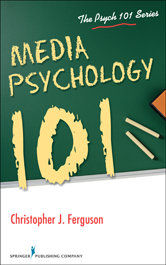- Email the Library
- 701.401.4229
-
Today's Hours:
| Today's Hours: |
|
Use these resources to find reference entries and books, which can help provide an overview of your topic and related issues.

This box will search books in the library, as well as some, but not all, of our ebook collection.
Search Books & ebooks:
 The Psych 101 Series: Media Psychology 101 by Christopher Ferguson
The Psych 101 Series: Media Psychology 101 by Christopher Ferguson